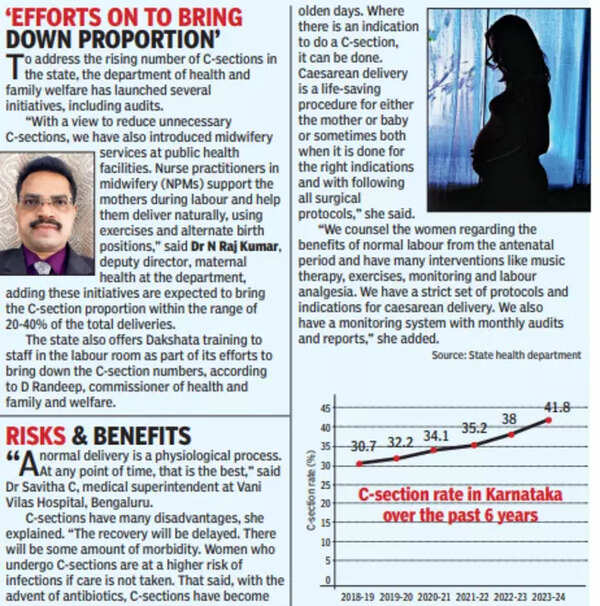- News
- City News
- bengaluru News
- Disorders, fear of labour pain drive up C-section deliveries
Trending
This story is from March 4, 2024
Disorders, fear of labour pain drive up C-section deliveries
The rise in C-sections in Karnataka is attributed to the increasing prevalence of medical disorders, caesarean delivery being more common among affluent women, infertility cases treated with ART, elderly women choosing caesarean, muhurat C-sections, and the commercialization of healthcare in private facilities.

Representative Image
Health and family welfare department data accessed by TOI shows that in 2018-19, only 30.7% of the total institutional deliveries in Karnataka were C-sections, while in 2023-24, the proportion went up to 41.8%. Out of 6,08,424 institutional deliveries registered in the state during the last reported year, 2,54,385 were C-sections.
The increasing prevalence of medical disorders like diabetes or hypertension complicating the pregnancy has contributed to the rapid rise in C-sections, said Dr Savitha C, medical superintendent at Vani Vilas Hospital, Bengaluru.
“Another interesting statistic is that caesarean delivery is more among affluent women due to perceived lower risks and fear of labour pain,” she said. “Rise in infertility cases treated with ART and elderly women with pregnancy who choose caesarean over normal delivery also have led to a rise in C-sections,” Dr Savitha added.
There is also a growing trend of opting for muhurat C-sections to coincide with an auspicious date and time.
The data shows that 65.1% of the total deliveries in Tumakuru in 2023-24 were C-sections. The C-section proportion in Tumakuru has been steadily climbing, with 57.8% in 2018-19, 58.6% in 2019-20, 61.2% in 2020-21, 62.2% in 2021-22, and 63.5% in 2022-23. Of the 21,439 institutional deliveries registered in the district since 2023, C-sections have accounted for 13,956.
Udupi, Chikkamagaluru, Chitradurga, Bengaluru Rural, and Kolar are among the districts with the highest proportion of C-sections, besides Tumakuru. Yadgir has reported a low proportion of C-sections, with 5.9% in 2018-19, 4% in 2019-20, 5.9% in 2020-21, 8.1% in 2021-22, 11.3% in 2022-23, and 9.4% in 2023-24.
Akhila Vasan of Karnataka Janaarogya Chaluvali attributes the rising trend in the state to the commercialisation of healthcare.
“Globally, the proportion of C-sections is less than 15%. Here as your data shows 40% are C-sections. There is only one reason for this: the commercialisation of healthcare.
If you disaggregate your own data by type of health facility, you will find that a substantially larger proportion of C-sections have taken place in private facilities. This trend has been seen for a very long time now. Many doctors say that complicated cases get referred to them.
But that is not true. If you try and see what proportion of the C-sections in private hospitals had a complication, you will find that it is a small percentage,” Akhila said. “Many doctors say women themselves ask for it.
That is also true. My question is: since when have doctors started deciding on surgeries based on what the patient ‘wants’. Also isn't it a doctor's duty to refuse surgeries when they are unwarranted? Who created the demand in the first place?” she said.

End of Article
FOLLOW US ON SOCIAL MEDIA











